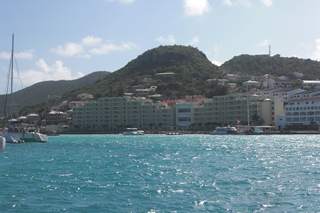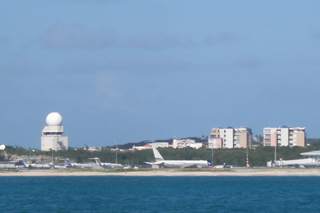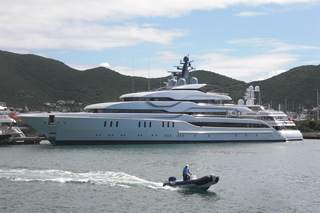23rd January 2012 - Mega Yacht Land

|
18:01.92N 63:05.90W 23rd January 2012 – Saint Martin/Sint Maarten
The sail to St Kitts started at 0740 on Saturday
14th January. It was a
little slow to start with but developed into a brisk downwind run in 20 -25
knots of breeze (Force 5-6) under one reef in the mainsail and poled-out full
yankee. There were a few squalls
with accompanying downpours to liven things up but we made it by 1750 (before
sunset) to anchor in On Sunday morning we again rose betimes to see what could
be done about this and having done what we could, set off at about 0800 to
complete the approximately 55NM passage to St Martin. Having rounded the western coast of
Having arrived in Simson Baai in Sint Maarten (the Dutch half of
Starboard View -
Pelican Resort
Port view – Our intention was to go into the lagoon the next morning
but it was all a bit of a mystery, the charted information was contradictory
(apart from the fact that all acknowledged that it really wasn’t very deep – at
least if you draw 8 feet) and inconclusive (helped by the statement on the
Admiralty charts; “Inadequately Surveyed”). We couldn’t get hold of any marina
offices and blah, blah. So, given
that we had about 2 hours before sunset, we launched the dinghy and motored into
the lagoon for a recce and to see if we could get any sense out of the marina
office we wanted to contact by battering down the door. No luck on the latter quest – it was a
Sunday and this isn’t the
Squeezing through the entrance to the lagoon
This is a ‘yacht’, apparently. Anyway, that was entertaining for a bit. We returned to Arnamentia for a pretty uncomfortable night aboard. Despite no indication in the generally excellent Doyle’s Cruising Guide, the anchorage was very rolly. No real problem – come what may we were going into the lagoon on the morrow. Monday morning dawned and Jon dinghied ashore to clear customs & immigration and pay the harbour authorities the $61 (US) required by them for the privilege of entering their territory. That’s before we start talking about any marina charges. Oh, and the charges for getting out again. Comfortingly, passage into the lagoon costs the mega yachts upwards of $500 a time. Quite right too. Anyway, all was fine until, having brought the dinghy alongside the dinghy dock, he dropped the boat and dinghy keys into the water. Shouldn’t have been a problem since these were attached to a big cork on the key ring. But it was because, not only were the keys attached to this but so was a rather attractive metal gizmo that meant he could easily identify which set of keys were his. So, the whole lot sank like a stone. No drama – the water was only about 4 feet deep – but recovering it did involve his stripping off to his underpants on the dock outside the customs & immigration office window, jumping in and then hanging about trying to dry off before dressing and presenting himself to a slightly bemused immigration official. (Regrettably, no photos available! – Dep Ed) We’ve removed the metal gizmo, you’ll be glad to hear. At 1130 the bridge re-opened to allow boats in. By this time we’d rung the selected marina office to establish that they could take us, precisely how they wanted us to berth and how we got there given the paucity of information about channels that would take our draught. Well, the guy on duty wasn’t usually on duty and didn’t really know and . . . So, off we went. We thought to trail behind the behemoths but were shooed ahead by one of the bridge marshals. We have no idea what he was thinking but we narrowly avoided being squished in the attempt at overtaking one of these things when it decided that it didn’t like the idea. But, we got through behind him and ahead of another similar monstrosity heading for the deep water mega yacht berths. Conscious of our draught (and the fact that we were not going for a deep water mega yacht berth, readily accessible from the entrance to the lagoon), we took matters pretty steadily, navigating with great care and at no more than about 3 knots. That was all a little too steady for one of the RIB outriders for the maritime block of flats behind us. He encouraged us quite robustly to get a move on. Fortunately, Jon was a bit busy at the time so Carol dealt with the exchange of information and views that was required. We followed the marked channels to the marina. They weren’t marked on the chart in much detail but they were on the ground – as it were. We followed them faithfully. We have been here long enough to understand ‘red right returning’. For non sailors; most of the civilised world understands that as you come into harbour you leave red buoys to port and green to starboard. However, in waters under US control or influenced by it, the opposite applies. Well; it would, wouldn’t it? When returning to harbour, leave red to your starboard (right) side. The one thing the man in the marina office had known was that RRR was something he should ensure we’d taken on board. We had. We touched bottom several times and went aground firmly twice in the soft
mud (the last time within 20m of our intended berth). It rather reminded Jon of Thorney Island
days and the book he never got round to writing: “Careening Sites in Once alongside, we got to the mundane business of hooking up to the shore
power electricity. Attention
non-cruisers; this is going to get a bit technical so you may want to skip to
the next paragraph. Naturally, we
hadn’t got the necessary On our last day there we hired a car to take a look around the island. The French (north) side is rather different from the Dutch (south) side. Think French cuisine and Dutch night life. The largest town, Philipsburg, the Dutch capital, was not to our taste. A half hour drive around the place taking in the tat juxtaposed with the bling on bling of the main street given over to selling duty free jewellery (sorry; jewelry) to cruise ship passengers was all that we felt moved to give it. The fact that our stay in Sint Maarten had lasted longer than a week required us to cough up another 60 odd USD for the privilege. Well, you see, a day is a week or a part thereof. The pain of this was eased by the fact that it took only about an hour and a half for Jon to check out of the island and pay the authorities their blood money in preparation for the next day. Apparently they’d got new software (well, a couple of months old) and were grateful for our support in their valiant efforts to make our payment visits as quick and efficient as possible. Give me a bod with a form and a couple of sheets of carbon paper any time. Not that our views would have counted, of course; we were but a couple on a poxy sail boat. So, our views on Sint Maarten?
It is unlike any other |



